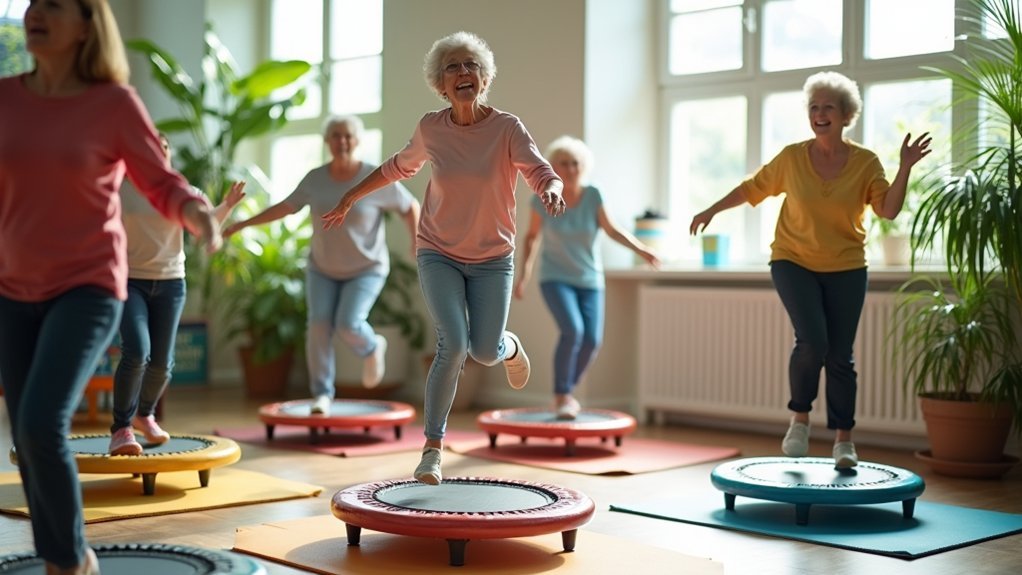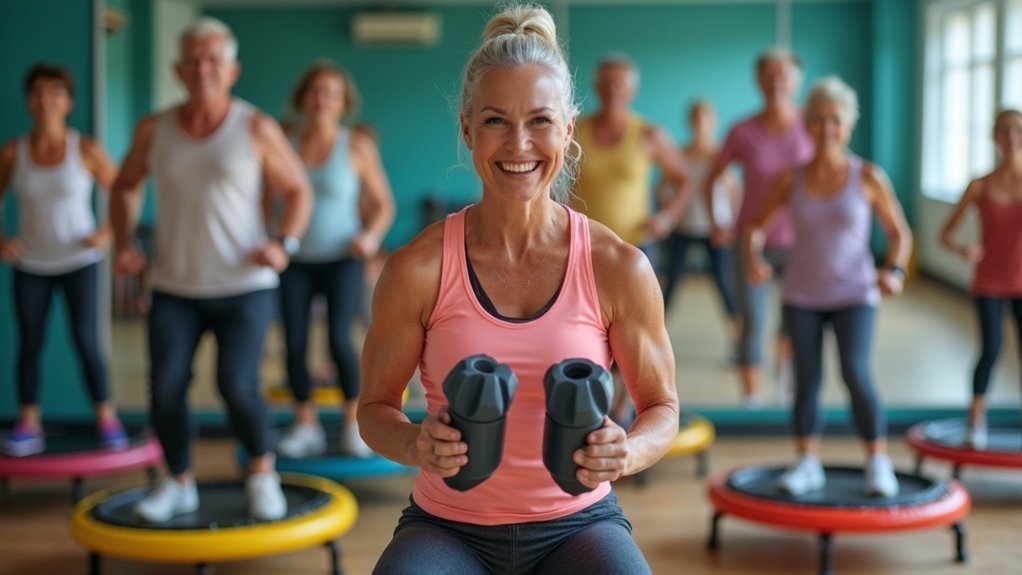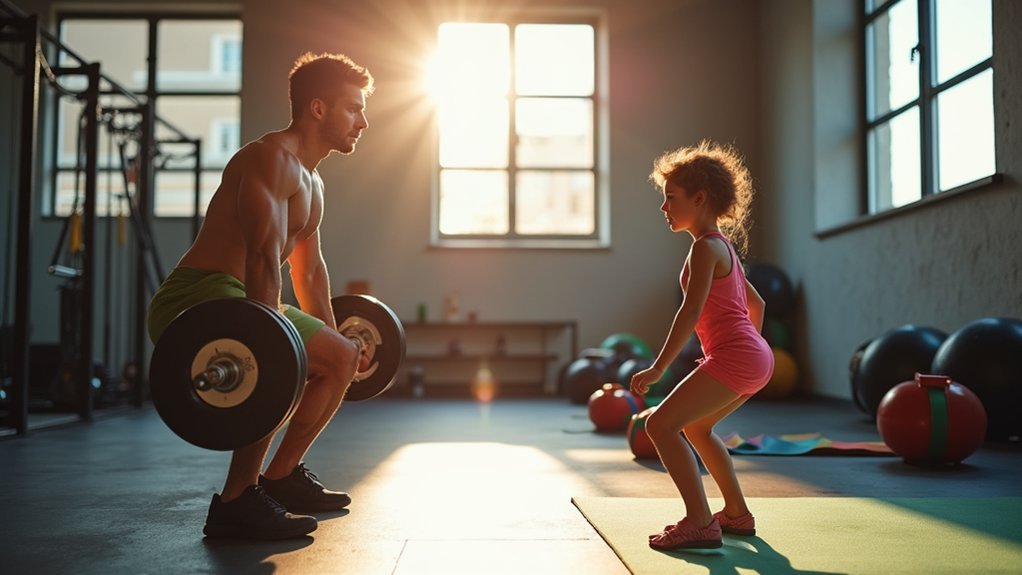Weight-bearing exercises like brisk walking, rebounding, and strength training effectively stimulate bone formation as you age. Aim for 15-30 minutes of activity 3-5 times weekly, focusing on proper form over intensity. Mini-trampoline rebounding offers a joint-friendly option that improves balance while strengthening bones. Start with gentle movements and gradually increase difficulty as your strength improves. The most effective bone-building routine combines various exercises tailored to your current fitness level.
Understanding Bone Health in the Aging Process

As we age, our bones undergo considerable structural and metabolic changes that can compromise their strength and durability.
After your fourth decade, bone remodeling slows, creating a negative balance where you lose more bone than you create.
You’ll experience increased porosity in cortical bone and thinning of trabecular connections—changes that affect both men and women.
This isn’t just normal aging; it’s a health concern affecting millions. About 20% of Caucasian women over 50 have osteoporosis, with over half showing low bone mass. It’s important to note that Asian-American women face similar risks, with 20% having osteoporosis and many others showing low bone density after age 50.
Your hormonal shifts during menopause or andropause considerably impact bone density.
While genetics play a role, don’t underestimate how lifestyle factors like diet and physical activity can influence your bone health.
Many mistakenly accept weak bones as inevitable, but they’re often preventable.
Weight-Bearing Exercises for Senior Bone Density
Weight-bearing exercises stand at the forefront of bone density preservation for seniors. These activities force your body to work against gravity, stimulating osteogenesis as mechanical loads trigger bone-forming cells to increase calcium deposits.
Weight-bearing exercises ignite bone-forming cells through gravitational resistance, making them essential for maintaining skeletal integrity in advanced age.
For ideal results, aim for 15-30 minutes of exercise 3-5 times weekly. You’ll benefit most from combining different approaches: try brisk walking or low-impact aerobics if you have mobility concerns, or incorporate short bursts of vertical jumps if you’re more able-bodied. Jogging provides more pronounced effects on bone health compared to leisurely walking activities.
Multi-directional movements like lateral stepping provide varied mechanical stress that enhances bone adaptation.
Remember that bone strengthening is site-specific—hip and spine bones respond to walking, while wrist bones benefit from resistance training.
Wear cushioned shoes, stay hydrated, and consult a physiotherapist if you have osteoporosis or joint pain.
Low-Impact Rebounding: Safe Bouncing for Older Adults

Low-impact rebounding offers a gentle yet effective exercise option for seniors seeking to maintain bone health without stressing fragile joints. The mini-trampoline’s surface absorbs impact, protecting your spine and hips while still providing enough resistance to stimulate bone remodeling.
You’ll improve balance and coordination as your core engages during each bounce, developing better proprioception and reducing fall risk. The rhythmic motion increases oxygen flow and stimulates lymphatic drainage without overexerting your heart.
Even gentle bouncing sessions provide weight-bearing stimulus that strengthens bones, while simultaneously improving joint hydration. Many rebounders come with assist rails for those using walkers or canes, making this exercise accessible regardless of mobility level. Rebounding actively stimulates bone growth, which is essential for seniors at risk of osteoporosis.
The endorphin release and potential for social engagement through group classes add mental wellness benefits to this bone-strengthening activity.
Progressive Rebounding Techniques for Osteoporosis Prevention
Mastering precision bounce progressions on your rebounder can greatly strengthen bone-vulnerable areas through deliberate, controlled movements.
You’ll want to start with gentle bounces while maintaining proper form, then gradually increase your height and speed as your confidence grows.
Controlling your rebound intensity allows you to safely challenge your bones with progressive resistance that adapts to your improving strength and balance capabilities.
However, research indicates that rebounding exercises may increase the risk of vertebral compression fractures if performed with improper technique or poor posture.
Precision Bounce Progressions
The gentle yet effective nature of rebounding exercises makes them an ideal choice for older adults concerned about bone health. At 68, you can benefit from a twice-weekly routine on a mini-trampoline that progressively increases in complexity as your confidence grows.
Begin with simple balance exercises, then gradually incorporate:
- Varied foot positions during jumps to challenge different muscle groups
- Upper and lower limb strengthening movements while maintaining stability
- Progressive intensity increases without harmful spinal flexion
These precision progressions help reduce your fear of falling while improving stability.
It’s critical to avoid rapid or jerky movements during your rebounding practice to minimize fracture risk, especially if you already have bone density concerns.
Always practice under healthcare provider guidance to ascertain exercises remain safe and effective. The combination of rebounding with resistance training creates a prime environment for strengthening aging bones while enhancing overall mobility.
Controlled Rebound Intensity
For individuals concerned about bone health, controlled rebound intensity offers a scientifically-backed approach to osteoporosis prevention. Start with gentle bouncing (2-3 inches) and gradually increase session duration from 10 to 45 minutes over 12 weeks. You’ll need to maintain safe ground reaction forces of 1-2 times your body weight. This approach aligns with the Onero Program’s focus on impact-loading activities that effectively stimulate bone remodeling.
| Intensity Level | Technique | Benefits |
|---|---|---|
| Beginner | Gentle bouncing with parallel feet | Activates bone-loading forces safely |
| Intermediate | Staggered stance with 4-inch rebounds | Distributes forces across hips/spine |
| Advanced | Multi-directional movements with core engagement | Maximizes osteogenic stimulus |
Alternate foot positions during sessions and incorporate side-to-side movements to stress bone networks from multiple angles. This approach has shown 32-45% improvement in balance compared to controls, while reducing fall risk through proprioceptive training.
Combining Rebounding With Strength Training for Maximum Results

As aging accelerates bone loss, combining rebounding with strength training creates a powerful strategy to maintain skeletal integrity beyond what either approach achieves alone. This powerful duo offers synergistic benefits for bone density and fall prevention.
For peak results, incorporate these strategic pairings into your routine:
- Alternate between squats and short rebounding intervals to strengthen lower body muscles while stimulating bone formation.
- Perform resistance band rows followed by gentle upright bouncing to build upper body strength and stimulate spine density.
- Practice single-leg balances before mini-trampoline exercises to enhance proprioception and balance.
Aim for 2-3 weekly rebounding sessions (20-30 minutes) alongside 2 strength workouts. The low-impact nature of rebounding makes it particularly suitable for those with joint concerns who still need weight-bearing exercise.
You’ll need patience—measurable bone density improvements typically require at least 16 weeks of consistent training.
Always prioritize proper form over intensity, especially if you have existing bone concerns.
Creating a Sustainable Rebounding Routine for Long-Term Bone Health
Sustainable rebounding routines demand more than sporadic exercise—they require thoughtful planning that balances bone stimulation with recovery time.
Design your program for at least 12 weeks, with 45-60 minute sessions 2-3 times weekly, alternating with rest days to prevent injuries.
Consistency beats intensity—commit to 12 weeks of alternating rebounding and recovery for optimal results.
Start with static balance exercises before progressing to low-impact bounces under 10cm height.
Track your progress using balance benchmarks like timed single-leg stands (aim for 30+ seconds by week 8) and functional tests like chair stand times.
For better adherence, consider morning sessions when bone remodeling is optimized, or try three 15-minute sessions throughout your day. Studies show that regular rebounding can increase bone density in the hip and spine, particularly important for aging adults.
Exercise barefoot or in minimal shoes to enhance proprioception, and always guarantee a clear space around your rebounder for safety.
Frequently Asked Questions
Can Swimming or Cycling Benefit Bone Density?
Neither swimming nor cycling considerably improves your bone density. You’ll need to combine them with weight-bearing exercises and resistance training to counteract potential bone loss and maintain skeletal health as you age.
How Quickly Can Bone Density Improve With Regular Exercise?
You’ll begin seeing metabolic improvements within weeks, but measurable bone density increases typically take 6-12 months of consistent weight-bearing exercise. You’re slowing bone loss immediately, even before density measurements show significant gains.
Should Seniors With Artificial Joints Modify Bone-Strengthening Routines?
Yes, you’ll need to modify bone-strengthening routines with artificial joints. Work with your orthopedic surgeon and physical therapist to choose low-impact, joint-friendly exercises while avoiding high-impact activities that could damage your implants.
Are Protein Supplements Necessary for Bone Health During Exercise?
Protein supplements aren’t necessary for bone health during exercise if you’re consuming adequate dietary protein (1.0-1.2g/kg/day) and calcium (>800mg/day). They’re most beneficial when your diet lacks these nutrients or you’re at higher fracture risk.
Can Meditation or Stress Reduction Impact Bone Strengthening Results?
Yes, meditation and stress reduction can boost your bone strengthening results by lowering cortisol levels that harm bone density. You’ll experience better exercise focus and improved sleep quality, which supports overall bone health.
In Summary
Don’t underestimate the power of rebounding to revolutionize your bone health as you age. By incorporating progressive bouncing exercises alongside traditional weight-bearing and strength training, you’re building a thorough defense against bone loss. Start slowly, remain consistent, and you’ll not only strengthen your skeletal system but also improve your balance and energy levels. Your bones will thank you for this gentle yet effective approach.





Leave a Reply